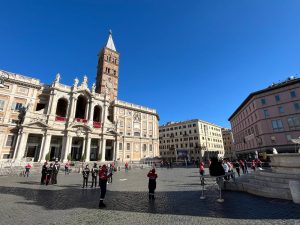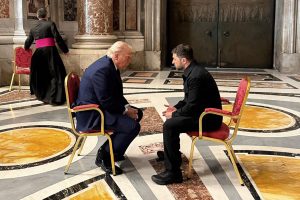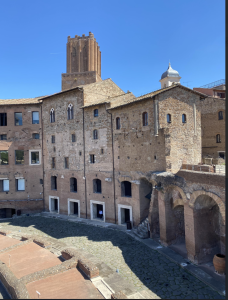Trump, the Pope, and the Fundamental Truth About Empires
The first thing I saw on landing in Rome was US President Donald Trump’s Airforce One parked just off the runway. He was in the city for Pope Frances’ funeral.
Pope Francis was the first South American to hold the post. His opposition to pomp and ceremony was widely known and his funeral, for which he had left instructions, was remarkable in its simplicity.
The pope was put into a plain wooden coffin and taken to the church of Santa Maria Maggiore, near a railway station where many immigrants are to be found. He was buried beside his favorite icon of the Virgin Mary, the ‘Salus Populi Romani’, where he liked to pray before he travelled.
This icon plays a very important part in the spread of Catholicism to the rest of the world as it was the first painting that was allowed to be copied (by the pope in the 17th century) and gained popularity in many parts of the world including Japan, China and South America.

Santa Maria Maggiore where Pope Francis is buried. Photo: Radhika Jha
The Catholic Church embraced the world and Pope Francis’s funeral was a reminder that it did indeed succeed in becoming a global religion.
A pope’s funeral is a super VIP event. The city was crammed with politicians and the police. There were hundreds of heads of state at the funeral service at St. Peters and hotels were full as it was a long weekend in Italy. But an image from this day that will be remembered for a long time is that of Presidents Trump and Volodymyr Zelesnkyy, sitting on two folding chairs in St. Peters, their heads close together. Of course, no one knows what was discussed.
Pope Francis believed in migration and in peace. His first ever official voyage as pope was to migrant camps in Lampedusa where he held a mass. Cardinal Re, the oldest cardinal who gave the speech at the service on Saturday, emphasised that Pope Francis had repeatedly urged the world to "build bridges, not walls". "War, he said, results in the death of people and the destruction of homes, hospitals and schools. War always leaves the world worse than it was before: it is always a painful and tragic defeat for everyone."

Ukraine's President Volodymyr Zelenskyy, right, and President Donald Trump, talk as they attend the funeral of Pope Francis in Vatican, Saturday, April 26. Photo: PTI/Ukrainian Presidential Press Office
The atmosphere on the streets was one of peace and excited anticipation, despite the large crowds. Even the police were relaxed and smiling. There were almost no cars in the central part, and most – though not all – of the tourists, who had come from all corners of the world, were there for the Pope.
To escape the crowds, I ducked into the Mercato di Traiano, Trajan’s market, which is a little visited but incredible three-story brick structure adjacent to the Foro Romano, built around the first century AD. This was built as an art and culture complex to celebrate Trajan's victory over the Dacians.

The medieval barracks where the Trajan's market once stood. Photo: Radhika Jha
There was a market, administrative buildings, a temple to peace which was fundamentally an open-air museum with sculptures by the finest sculptors of the time, music auditoriums, public plazas, more temples and public rooms for cultural events.
And of course, the crown jewel: Trajan’s column, which tells the story of the war against the Dacians in graphic detail, almost like a three dimensional comic strip with beautifully carved friezes that spiral up the column.
I couldn’t help thinking of another city I had seen not so long ago with a similar esplanade, cultural spaces and a striking memorial – Washington D.C., created when the US first sought to engage with the world, with the Greeks and Romans very much in mind.
But like everything in Rome, where history doesn’t come in bits and blobs but in layers, Trajan’s market was soon repurposed by the early Christians into military barracks, complete with a medieval tower. Later, in medieval times, it was broken into sections, one of which became the headquarters of the order of Malta and the other a nunnery.
As I stood there, looking at some of the most fantastic ruins I had ever seen, thinking about empires and history, it struck me that empires are, by nature, cosmopolitan and inclusive. They have to be. This was as true of Ashoka or the Mughal empire as it was of the Greeks, the Romans, the Persians, the Ottomans, or the Americans.
It is when they stop being tolerant and inclusive that the empire breaks apart and plunges the world into chaos and war. This is a pattern that we have seen repeated over and over again. What we are facing today is no different.
Radhika Jha is a novelist. Her recent novels include The Hidden Forest and My Beautiful Shadow, both published by Westlands Press.
The Wire is now on WhatsApp. Follow our channel for sharp analysis and opinions on the latest developments.




